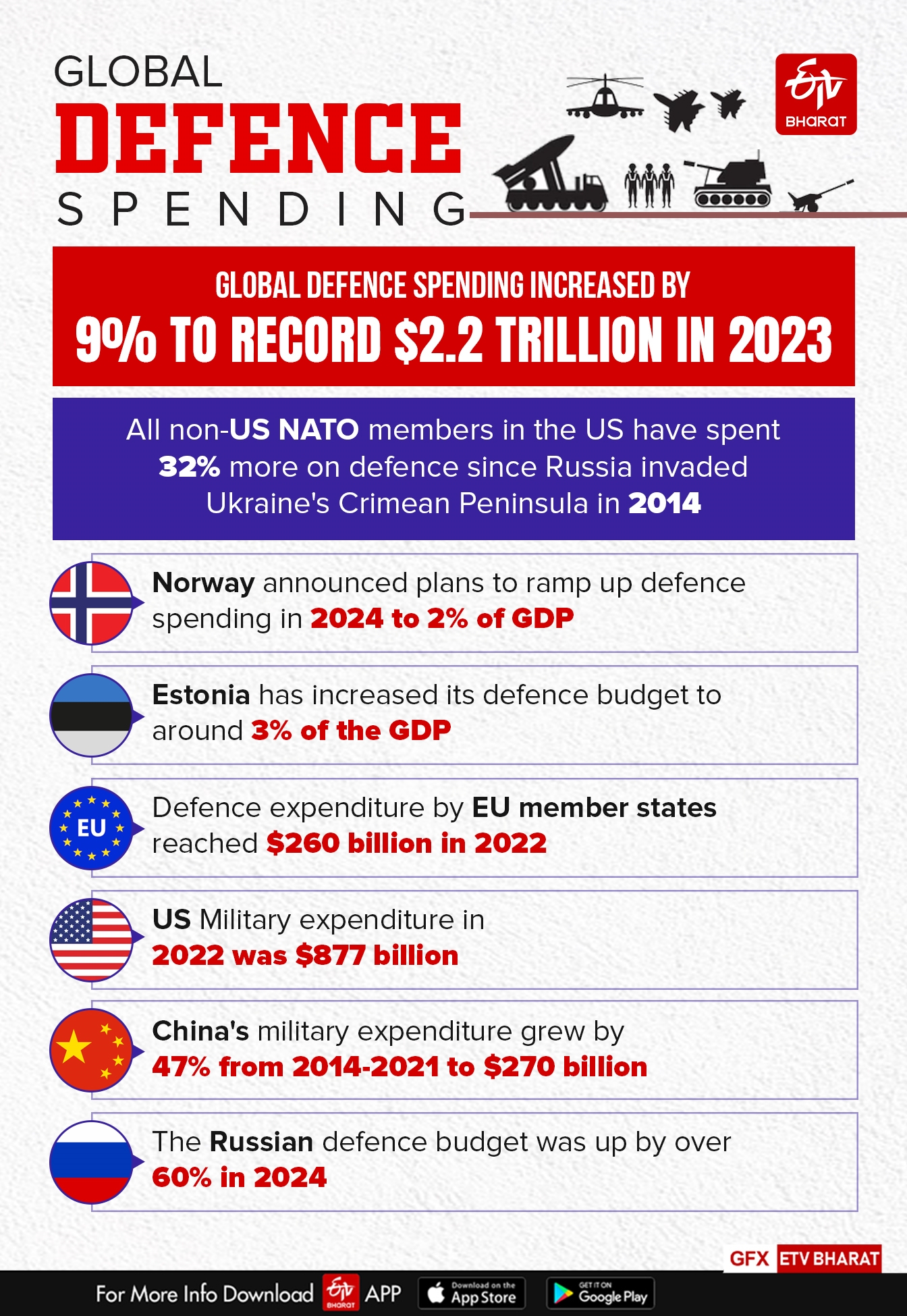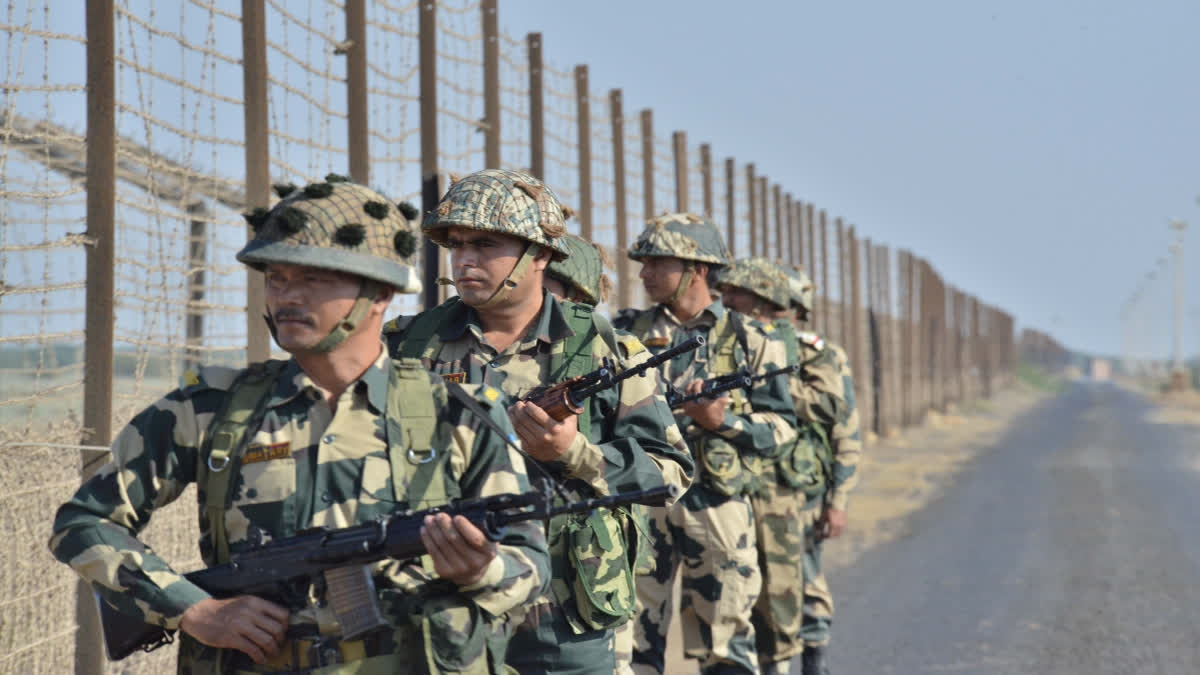Global defence spending increased by 9 per cent to a record $2.2 trillion in 2023 motivated by geopolitical tensions caused by Russia’s invasion of Ukraine and the serious rise of military costs seems likely to continue in 2024. Regardless of world defence spending reaching a record $2.2 trillion, United States (US) and European Union (EU) countries have expected to rearm themselves amid growing tensions with Russia, efforts to slow down China's technological rise, President Xi Jinping's target to bring Taiwan under Beijing’s control and its proclaimed maritime claims in the South China Sea.
Moreover, the Israel-Hamas conflict, the Red Sea crisis and very recent Iran’s drone and missile attack on Israel are also adding to the volatile environment of the world. A report from the International Institute for Strategic Studies (IISS) also mentioned growing disturbances in the Arctic, North Korea's pursuit of nuclear weapons, Tehran's growing influence in conflict zones and the rise of military regimes in the Sahel region of Africa.
Lessons learned from the war in Ukraine influenced many countries to amplify the production of military hardware and to build up stocks in case they are enforced to fight a long-drawn-out war. Consequently, to maintain an advantage over adversaries more military spending is required to stock up weapons and ammunitions and also to tackle challenges like cyber warfare, and terrorism, and to keep investing in new technologies to combat new threats posed by unmanned aerial vehicles (UAV) and hybrid warfare modus operandi.

According to IISS report, all non-US NATO members in Europe have spent 32 per cent more on defence since Russia invaded Ukraine's Crimean Peninsula in 2014. The Vilnius summit of NATO held in July 2023 set a target for member countries to commit to spending at least 2 per cent of their gross domestic product (GDP) on defence yearly.
19 members of them spend more than 2 per cent of GDP in 2023. Norway the NATO member country recently announced plans to ramp up defence spending in 2024 to 2 per cent of its GDP and Estonia, a former Soviet republic, has increased its defence budget to around 3 per cent of GDP.
While NATO members have been boosting their defence spending to get closer to the target of 2 per cent of GDP, some military experts think that expenditures will need to go up to a level of 4 per cent of GDP to deal with deteriorating situations in future. If it were to happen, according to Bloomberg Economics, it would demand an additional $10 trillion in military spending over the next 10 years among the US and its allies.
Yet coping with NATO’s 2 per cent of annual GDP minimum for defence spending has already led to harsh deliberations in Europe. NATO members are unlikely to agree to a firm commitment to spend as much as 4 per cent of GDP on defence because of severe cuts in other parts of their budgets. Bloomberg claims that countries like the US, France, Italy and Spain would be getting to 4 per cent would push them to make painful choices between deeper levels of borrowing or augment in taxes.
The unending Russia-Ukraine war has placed significant financial pressure on NATO member countries. The US largest contributor of NATO is accounting for over 65 per cent of the organisation’s total spending in 2023 and granted over $75 billion to Ukraine since the war began. Preparing for future security challenges with a 4% of GDP will connote considerable costs and some hard and strong decisions for EU countries and the US which are already struggling with unsteady public finances.
Financial experts feel that it is too early to declare how the rapidly increasing arms buildup will affect public finances, but undoubtedly such commitments will affect welfare and health needs. Some economists argue that the increased military spending will aggravate inflation and put pressure on interest rates, where as some experts deny it and argue that wealthy Western governments can manage such fiscal demands.
In accordance with McKinsey, defence expenditure by the EU member states reached a record of $260 billion in 2022, a 6 per cent increase from 2021 and annual defense outlays could mount to €500 billion by 2028. McKinsey also estimates that European countries saved $8.6 trillion over the past few decades, compared to average defence spending from 1960 to 1992, by reducing the size of their armies. However, Putin’s aggression has forced Europe to discard its past approach and setting up to strengthen their militaries.
The US military expenditure in 2022 was $877 billion, which increased to $ 905.5 billion in 2023 and it is allocating 3.3 per cent of its annual GDP on defence. China’s military expenditure grew by 47 per cent from 2014 to 2021, to $270 billion and its defense spending will grow by 7.2 per cent in 2024.
The Russian defence budget was up by more than 60 per cent in 2024 - one-third of its national budget and will now reach 7.5 per cent of GDP. Even though European countries still spend less on defence than the NATO target of 2 per cent of GDP, Russia cannot match the combined defence budget of NATO's member states, even without the US.
In the case of 22 Asia-Pacific nations, an analysis by defence intelligence firm Janes reveals that Malaysia leads the year-on-year growth projections with a 10.2 per cent increase and total outlays of $4.2 billion this year followed by 8.5 per cent growth for the Philippines with $6.6 billion.
Indian defence budget was increased to ₹6, 21,541 crore (US$78 billion) in 2024-2025 from ₹5, 93,538 crore (US$74 billion) for the fiscal year 2023-2024. By and large, the US remains the largest global military spender more than the next 15 countries combined, including China and Russia, which are in second and third positions. India and Britain were ranked fourth and fifth respectively.
Larger defence budgets alone will not solve the conflicts and volatile security and strategic problems. To defend Beijing’s rising assertiveness, Moscow’s ongoing invasion of Ukraine, chaos in West Asia and as well challenging security situations elsewhere, the West has to develop more comprehensive security coalitions and networks, cultivate their economies jointly with the countries of Asia, Africa, the Middle East and South America, rather than demanding a system focused on Western supremacy, personal advantage, especially without regard for other countries.
The effective strategy that the West can pursue is to strengthen their cooperation with India, a major security and economic player in the Indo-Pacific, and also China’s neighbour to the West.


